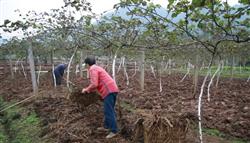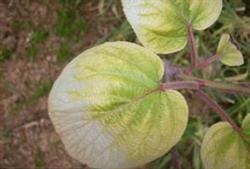Kiwifruit planting techniques: what should kiwifruit pay attention to in summer?

What should kiwifruit pay attention to in summer? Please introduce the following points to prevent kiwifruit in summer: anti-wilting kiwifruit leaves wilt during high temperature in summer, there are two main reasons: one is high temperature and drought, which mostly occurs from 12:00 to 4pm on sunny days. Recovery sooner or later, usually occurs in a large area. This kind of situation should be irrigated in time in the morning and evening, and the wilting can be relieved. Second, the root system suffers from root rot and root-knot nematode disease, which leads to pathological wilting caused by the destruction of root function. The performance was the most serious at noon, and lasted for a long time, and even showed symptoms sooner or later, and showed sporadic characteristics. Once it is found that the root should be planed and examined, if it is really harmful to diseases and insect pests, the branches and leaves should be cut off properly, some or all of the fruits should be removed, and agricultural resistance 120 and fungicide should be selected to irrigate the roots. In the case of root-knot nematode disease, an appropriate amount of 10% grams of phosphorus or clenbuterol insecticides should be added when irrigating roots. Preventing sunburn is a common physiological disease of kiwifruit in summer. In addition to adopting the measures of irrigation in high temperature period, reasonable summer shearing, maintaining suitable leaf-fruit ratio and controlling fruit load, Merrill Lynch efficient calcium was sprayed twice in the young fruit stage (15 seconds 20 days apart), and the exposed fruits were bagged one by one, which can effectively prevent sunburn and other physiological diseases. It is easy to grow and shade the fruit trees in the full fruiting period, ignoring the wiping of buds, partial application or re-application of nitrogen fertilizer. The method of prevention and control is to popularize the small branch and multi-bud shearing in winter in ① to reduce the number of branches left on the tree. In summer, ② gently wiped buds and re-coring, leaving 3 Mel 4 leaves on the secondary branches germinated after the first coring, and 1 Mel 2 leaves on the third branches repeatedly. ③ opened the light path and repeatedly picked the hearts of the outer branches (the second to the iron wire) and the fruit branches 2Mel 3 leaves to remove the vegetative branches. ④ truncated and thinned the weak fruiting branches and temporary fruiting branches under the shelf. Old leaves and yellow leaves were removed by ⑤. By taking the above measures, we can achieve the high-yield garden appearance of "no winding on the tree, a gap between the rows, the shadow of flowers under the tree (about 30% light transmittance), and sunlight on branches". Preventing wind damage and strong wind weather does great harm to kiwifruit trees, and the solution is to bind vines well. The basic requirement is that the orchard in the limelight should be tied up with branches and attach importance to the construction of windbreak forest. In general, orchards should adhere to the outside but not the inside, tie up without binding down, and tie up without being tied to death. The binding method of "8" shape should be promoted. Click to get more kiwifruit planting techniques click to get more fruit planting techniques
- Prev

Kiwifruit planting technology: how to fertilize kiwifruit?
How to fertilize kiwifruit? Please give guidance for the cultivation of kiwifruit can refer to the following methods for fertilization: kiwifruit absorbs a large amount of inorganic nutrient elements, and after sprouting, in different periods such as leaf expansion, flowering and fruit development, the absorption of various nutrient elements is different. ...
- Next

Kiwifruit planting techniques: how to prevent and cure kiwifruit chlorosis?
How to prevent and cure kiwifruit chlorosis? Please introduce the control methods of kiwifruit yellowing, we can refer to the following methods to control kiwifruit yellowing: choosing the garden site, the soil pH value of the production and cultivation garden is between 5.5 and 7.5, the soil is better with light loam, medium loam and sandy loam with good permeability.
Related
- Moge, come on! The staff of the peasant association in the producing area of cantaloupe were frightened when the crowd gathered.
- Causes and Solutions of low Fruit setting rate of Apple
- Symptoms and control measures of passion fruit virus disease
- Fruit growing lesson: how do apple orchards keep high yields?
- Can you build orchards in the mountains? What are the pros and cons?
- How to manage the coloring period of Crisson grape?
- This paper introduces the processing technology of two kinds of fig products.
- How much is a month for retired teachers in rural areas by 2020?
- How can strawberry planting increase sugar content? We should pay attention to management in many aspects.
- What are the cultivation techniques on how to improve the yield of golden fruit?

